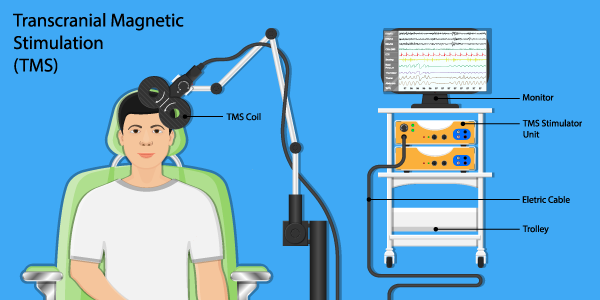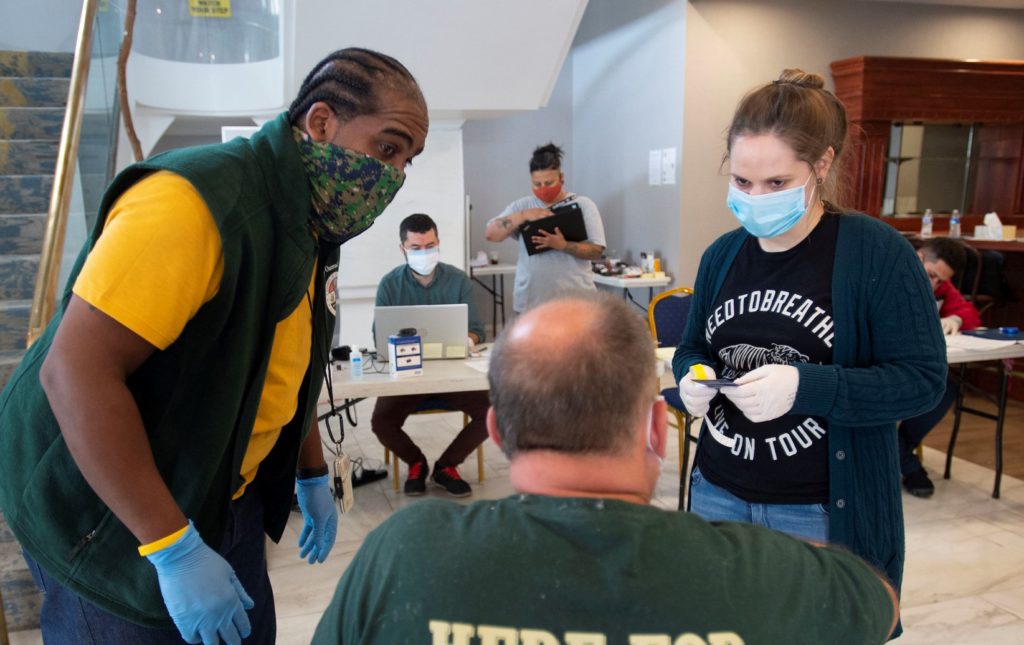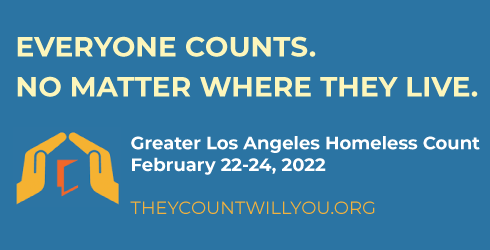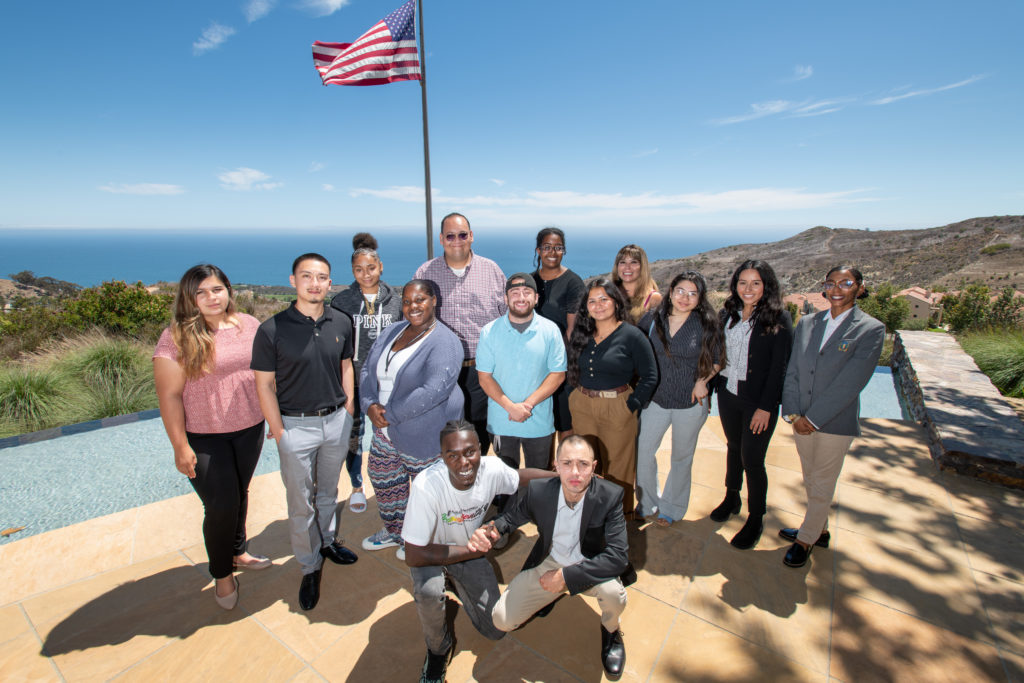Innovation Project Highlight: Transcranial Magnetic Stimulation
by H. Chung So, Public Information Officer

Thanks to support from California’s Mental Health Services Act (MHSA), LACDMH has been able to provide transcranial magnetic stimulation (TMS) to treat clients experiencing depression symptoms that are resistant to first-line treatment, such as medication and psychotherapy. While TMS was approved by the Food and Drug Administration to treat depression in 2008, it has only been primarily available in private healthcare systems, and LACDMH is one of the first public mental health systems to offer this safe and highly effective treatment for our clients.
With TMS, a magnetic coil is placed on the surface of the client’s head and it is then activated to generate a magnetic field to stimulate specific areas of the brain, providing immediate relief from symptoms as well as long-term relief with repeated applications (a typical course of treatment is five TMS sessions a week over four to six weeks.)
“TMS is very effective for treating depression, and is being studied at other organizations for other behavioral conditions such as bipolar disorder, schizophrenia, post-traumatic stress disorder, substance use disorders, and suicidal crises,” said LACDMH Associate Medical Director Marc Heiser, M.D., Ph.D. “We are excited to be able to offer TMS for clients who have not responded as well to first-line interventions for depression.”
Heiser also emphasized that TMS is not electroconvulsive therapy (ECT) – which involves directly applying electricity to the brain to induce a brief, controlled seizure while the client is asleep under anesthesia. Unlike ECT, clients remain awake during TMS sessions, and it is generally better tolerated with fewer and less severe side effects compared to ECT.
“The magnetic pulses are delivered in very short bursts, and it feels like a tapping on the head,” Heiser said. Most common TMS side effects include headaches and lightheadedness, and they are typically mild and brief. In contrast, side effects of ECT are more intense and can include nausea, muscle aches, and memory loss.
As part of MHSA’s Innovation Project series—which introduces and implements novel mental health treatments and practices to improve service delivery and clinical outcomes—LACDMH has been able to acquire and operate one TMS machine and has treated approximately 60 clients. Based on the positive outcomes of this project, with most patients experiencing sustained relief from symptoms with minimal side effects, LACDMH hopes to acquire more TMS machines and staff so more clients in L.A. County can access this safe and highly effective treatment.
Clients surveyed about their level of pain/discomfort on a 0-10 scale reported an average of “2” during the TMS session and “1” after the session. Most clients also reported being satisfied or very satisfied with TMS treatments, and clinical evaluations of depression symptoms have shown improvement following TMS treatment with a significant reduction in symptom severity.
Given the proven benefits of TMS in the current MHSA project – Heiser said LACDMH plans to apply for additional MHSA innovation project support to acquire more TMS machines and hire staff to operate them. This, as well as Medicaid’s upcoming coverage of TMS treatments in July 2023, would expand its availability to more clients throughout L.A. County. Furthermore, Heiser said FDA may approve TMS to treat additional behavioral conditions given its promising results from clinical trials, expanding its use potential for a wider group of clients. (Note: LACDMH is only providing TMS therapy for FDA-approved uses and is not a participant in these clinical studies.)
Currently, clients of LACDMH directly operated clinics can speak to their mental health care provider to be considered for TMS therapy for depression. Once additional machines and staff are available and online, Heiser expects our department to be able to provide TMS therapy to clients of LACDMH contract providers as well. To learn more about this treatment, visit the TMS page on the National Institute of Mental Health’s website.
Get Involved! Join the 2022 Homeless Count
The Los Angeles Homeless Services Authority (LAHSA), which coordinates housing and supportive services for individuals experiencing homelessness, will be conducting its 2022 Greater Los Angeles Homeless Count from February 22 to 24, 2022. LAHSA is currently seeking volunteers to help with this year’s count throughout Los Angeles County.
“The Homeless Count is an essential tool in giving us a point-in-time snapshot of homelessness. Data from the Count is used to inform the delivery of services and programs for people experiencing homelessness in Los Angeles,” said LAHSA Executive Director Heidi Marston.
To protect the health and safety of volunteers, unhoused individuals, and staff during the count, LAHSA has implemented the following changes to reduce the risk of COVID-19 exposure and transmission, including:
- Moving most deployment sites will be outdoors— at many sites, volunteers will not leave their cars to pick up their count packets
- Moving training sessions online to minimize the time volunteers spend at the deployment sites
- Including COVID safety instructions as part of the mandatory training
- Requiring all volunteers to wear masks, and making personal protective equipment accessible to all participants
- Encouraging all volunteers to be vaccinated
For more information on the 2022 Homeless Count and to sign up, visit https://theycountwillyou.org.
Join Us for L.A. County Youth Commission’s “Centering Voices in Mental Health” on Feb. 10
LACDMH, in partnership with the L.A. County Board of Supervisors and Youth Commission, will be holding a virtual meeting on Feb. 10, to discuss and highlight the mental health needs of L.A. County youth and gather community input and feedback, with a special focus on youth lived experiences and voices and how they can be used to build or improve wellbeing programs throughout the County.
Speakers at this event include L.A. County Youth Commissioners, experts from the DMH+UCLA Public Partnership for Wellbeing, and community mental health advocates.
“Young people in LA County are resilient and strong. By seeking their feedback for improving mental health and wellbeing services across the County, we can help youth-serving organizations meet their needs and prevent future mental health crises,” said Youth Commissioner La’Toya Cooper, who represents the Second District.
“We are thrilled to partner with the Youth Commission which is positioned to help amplify the voices of young people who have never had a proper platform for providing input to county systems,” said Dr. Jonathan Sherin, director of LACDMH. “It is our belief that the Youth Commission will inspire new and more effective models of mental health care for young people in L.A. County.”
The meeting will take place on Thursday, Feb. 10, 2022, 6 p.m. to 7 p.m., on Zoom. If you would like to submit a question to the speakers, please do so on the Youth Commission’s Instagram page by Feb. 4.
Meet HOME Team Member Bobby Higareda
by H. Chung So, Public Information Officer
 Adalberto “Bobby” Higareda, Jr., is a community health worker with LACDMH’s Homeless Outreach and Mobile Engagement (HOME) Program. In this Q&A, you will learn more about his work, why he joined the HOME team, and insights from his experience working with individuals experiencing homelessness and serious mental illness.
Adalberto “Bobby” Higareda, Jr., is a community health worker with LACDMH’s Homeless Outreach and Mobile Engagement (HOME) Program. In this Q&A, you will learn more about his work, why he joined the HOME team, and insights from his experience working with individuals experiencing homelessness and serious mental illness.
How long have you been with LACDMH and the HOME Program?
I have been with this Department and the HOME Team for about three years, and this was my first job with L.A. County.
What led you to pursue this role with the HOME team?
Prior to joining HOME, I have worked in a similar capacity providing services to people from diverse backgrounds and cultures. Most recently, this was at Children’s Hospital Los Angeles, where I worked at the Division of Adolescent and Young Adult Medicine. There I was helping youths, including those experiencing or at risk of homelessness, get connected to services and educating them about resources and benefits they are eligible for. And that’s the type of work I do now but just with a different and broader group of people who also need help and support.
What is your day-to-day work like?
It’s very interesting because you might have something planned but might wound up doing something totally different because of how quickly client needs and situations change. read more…
Program Highlight: Homeless Outreach and Mobile Engagement (HOME) Team
by H. Chung So, Public Information Officer
Estimates show that approximately 26% of people experiencing homelessness in Los Angeles County have a diagnosed mental illness. With the largest population of unsheltered homeless people in the country located in our communities, LACDMH plays a pivotal role in assisting the most vulnerable unhoused individuals, and is making strides with our Homeless Outreach and Mobile Engagement (HOME) program. LACDMH HOME program was established to help people experiencing homelessness and persistent mental illness and support their journey to wellbeing, recovery, and connection with their communities.
The multidisciplinary group includes community health workers, registered nurses, psychiatrists, medical case workers, psychiatric technicians, and other clinical and administrative professionals who do “relentless outreach” to engage and help clients.
In 2021, HOME has helped over 2,100 clients and provided over 19,000 client-days of community outreach, mental health and medication support, crisis intervention, and targeted case management services.
“Our teams are out there day after day to help our hardest to reach individuals, including many who don’t think they need help,” said Aubree Lovelace, MFT, HOME program manager. read more…
Blog Search
About This Blog
“Connecting Our Community” is LACDMH’s blog highlighting our department’s news, updates, and resources for Los Angeles County residents and communities. We hope you find these articles useful for learning about our services and resources to promote your and your community’s wellbeing. If you have questions, feedback, or story ideas for this blog, feel free to contact us.



